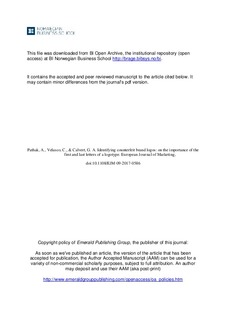Counterfeit brand logos: On the importance of first and last letters of a brand name
Journal article, Peer reviewed
Submitted version
Permanent lenke
http://hdl.handle.net/11250/2603038Utgivelsesdato
2019Metadata
Vis full innførselSamlinger
- Publikasjoner fra CRIStin - BI [1015]
- Scientific articles [2181]
Sammendrag
Purpose
Counterfeiting is a menace in the emerging markets and many successful brands are falling prey to it. Counterfeit brands not only deceive consumers but also fuel a demand for lower priced replicas, both of which can devalue the bona-fide brand. But can consumers accurately identify a counterfeit logo? This paper aims to explore this question and examines the accuracy and speed with which a consumer can identify a counterfeit (vs original) logo.
Design/methodology/approach
Seven popular brand logos were altered by transposing and substituting the first and last letters of the logotypes. Consumers then classified the logos as counterfeit (vs original) across two experiments.
Findings
Participants were faster and more accurate in identifying a counterfeit logo when the first letter (vs last letter) of a logotype was manipulated, thus revealing last letter manipulations of a brand’s logotype to be more deceptive.
Research limitations/implications
This paper comments only on the manipulation of logotypes but not of logo symbols. Similarly, findings may not be generalizable across languages which are read from right to left.
Practical implications
Counterfeit trade is already a multibillion dollar industry. Understanding the key perceptual differentiators between a counterfeit (vs original) logo can be insightful for both consumers and firms alike.
Originality/value
Research available on objective measures of similarities (vs dissimilarities) between counterfeit (vs original) brand logos is limited. This paper contributes by examining the ability of consumers to discriminate between counterfeit (vs original) logos at different levels of visual similarity.
